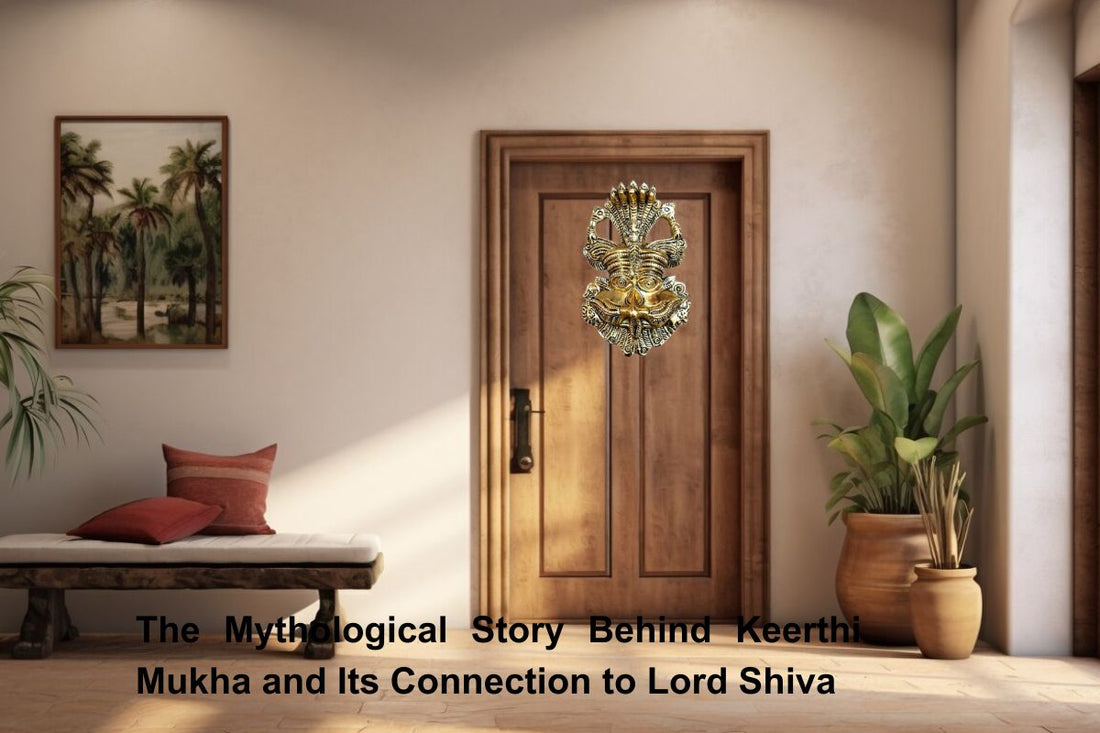Hindu mythology abounds with narratives that are steeped in deep spiritual significance. One of these stories is the legend of Keerthi Mukha, a fierce yet divine face which is commonly depicted on temple gates. This special symbol is highly related to Lord Shiva and symbolizes protection, humility, and divine justice. Most individuals think that having a keerthi mukha idol for home brass can impart positivity and keep negative energies at bay. The legend of Keerthi Mukha is not only an intriguing story but also a lesson in surrender and devotion.
The Mythological Legend of Keerthi Mukha
Keerthi Mukha's story starts with a mighty demon king by the name of Jalandhara. He was arrogant and wanted to test the strength of Lord Shiva. In order to achieve this, he dispatched his messenger, Rahu, with the ultimatum that Shiva must obey his authority.
Arrogant Rahu went to Lord Shiva and handed over Jalandhara's message. Infuriated by this audacity, Shiva unfolded his third eye and created a frightful creature. This creature had an unquenchable thirst and incredible strength, so it could not be controlled. When Rahu saw the awful creature, he trembled with fear and pleaded for mercy.
But the animal had no foe to fight or eat. Observing its increasing hunger, Shiva ordered it to devour itself. Without any delay, the animal did so and started eating its own body. Gradually, only its face was left.
Satisfied with its unshakeable devotion, Shiva consecrated it and gave it the name Keerthi Mukha, which means "glorious face." He ordained that its image would always be put at temple gates to act as a guardian. From then on, Keerthi Mukha has remained a revered sentinel in Hindu temple design.
The Symbolism and Spiritual Significance of Keerthi Mukha
Keerthi Mukha is more than a mythological creature; it holds significant spiritual value. It symbolizes self-denial, modesty, and ego annihilation. The beast's act of devouring itself is representative of how unbridled pride and conceit bring about one's destruction. It also reflects the need to submit to divine will.
Therefore, it is said by a lot of people that having Brass Keerthi Mukudu at home entrances will prevent evil energies. It is regarded as a very spiritual symbol that infuses positive vibrations and keeps things harmonious. In addition, Keerthi Mukha reminds us to shed pride and become humble in life.
Keerthi Mukha in Hindu Architecture
Keerthi Mukha is a frequently encountered figure in Hindu temple structures, especially along the entrances and above doors. Its intimidating countenance is used to deter harmful forces and secure the holy domain. Additionally, its presence helps to cleanse the temple and surroundings of their energies.
Today, numerous individuals install Kirthimukha for home door as a safeguarding feature. It is widely used by those who believe in Vastu Shastra and orthodox Hinduism. Installation of Keerthi Mukha at the entrance is said to generate a barrier against evil forces, bringing peace and prosperity to the household.
Besides temples, Keerthi Mukha is also found on the walls of ancient palaces and holy places. Its use in architecture is a reflection of its importance in Hindu culture. Even now, craftsmen make exquisite Keerthi Mukha sculptures in brass, stone, and wood for religious and ornamental purposes.
The Connection Between Keerthi Mukha and Lord Shiva
Lord Shiva is referred to as the destroyer of evil and the supreme force of change. The creation of Keerthi Mukha demonstrates his divine power and justice. In addition, it represents the ultimate surrender to the divine. The creature's readiness to devour itself without any resistance is a symbol of total obedience to Shiva's will.
Numerous Shiva temples have Keerthi Mukha placed over the entrance as a symbolic watchman. It is a reminder that arrogance and negativity need to be left behind prior to entering a holy space. Some followers also place Brass Keerthi Mukut at home or temples to develop a spiritually elevating atmosphere.
Having Keerthi Mukha within the Shiva temples also reminds that divine cover is ever within the reach for such people when offered with commitment. It teaches the lesson of what it needs for true worship that one needs humility and also enough courage to outgrow individual fault.
Why Keerthi Mukha Is Still Useful Today?
Even today, the importance of Keerthi Mukha is still very much prevalent in Hindu society. It imparts important lessons on humility, dedication, and the repercussions of arrogance. Additionally, its protective role is well known among spiritualists.
Most of the Christians use a keeper mukha idol at home brass in order to preserve positivity and holiness. It's not merely for decoration purposes, but also acts as an assertive icon that protects from the negative while guiding towards wisdom. The divine presence of Keerthi Mukha is known to welcome blessing from the lord while preventing evils.
The legend of Keerthi Mukha continues to guide believers generation after generation. It reminds everyone that genuine power rests in the selflessness of devoting oneself to the divine and shedding ego-based wishes. Either hung in temples or within one's homes, Keerthi Mukha stands as an all-powerful symbol of religious belief and moral advice.
Conclusion
The mythological legend of Keerthi Mukha is one of devotion, justice, and humility. It was formed by the divine power of Lord Shiva and is a symbol of protection and spiritual wisdom. Placed in temples and homes, it is said to ward off negativity and attract divine blessings.
Most individuals install Brass Keerthi Mukudu and Brass Keerthi Mukut for increasing the spiritual energy of the place. Furthermore, be it in temples or on home entrances, Keerthi Mukha still keeps us reminded of the strength of faith, humility, and surrender. Its fierce but divine face is an ageless guardian, defending holy places and leading devotees towards inner peace.

